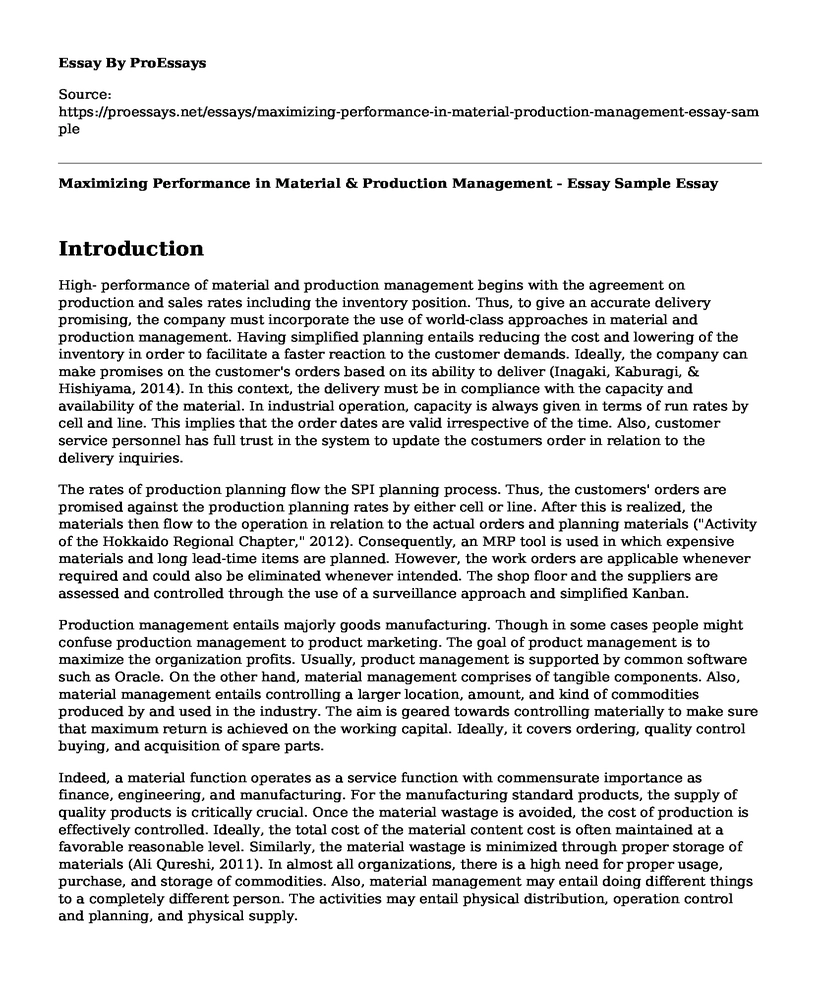Introduction
High- performance of material and production management begins with the agreement on production and sales rates including the inventory position. Thus, to give an accurate delivery promising, the company must incorporate the use of world-class approaches in material and production management. Having simplified planning entails reducing the cost and lowering of the inventory in order to facilitate a faster reaction to the customer demands. Ideally, the company can make promises on the customer's orders based on its ability to deliver (Inagaki, Kaburagi, & Hishiyama, 2014). In this context, the delivery must be in compliance with the capacity and availability of the material. In industrial operation, capacity is always given in terms of run rates by cell and line. This implies that the order dates are valid irrespective of the time. Also, customer service personnel has full trust in the system to update the costumers order in relation to the delivery inquiries.
The rates of production planning flow the SPI planning process. Thus, the customers' orders are promised against the production planning rates by either cell or line. After this is realized, the materials then flow to the operation in relation to the actual orders and planning materials ("Activity of the Hokkaido Regional Chapter," 2012). Consequently, an MRP tool is used in which expensive materials and long lead-time items are planned. However, the work orders are applicable whenever required and could also be eliminated whenever intended. The shop floor and the suppliers are assessed and controlled through the use of a surveillance approach and simplified Kanban.
Production management entails majorly goods manufacturing. Though in some cases people might confuse production management to product marketing. The goal of product management is to maximize the organization profits. Usually, product management is supported by common software such as Oracle. On the other hand, material management comprises of tangible components. Also, material management entails controlling a larger location, amount, and kind of commodities produced by and used in the industry. The aim is geared towards controlling materially to make sure that maximum return is achieved on the working capital. Ideally, it covers ordering, quality control buying, and acquisition of spare parts.
Indeed, a material function operates as a service function with commensurate importance as finance, engineering, and manufacturing. For the manufacturing standard products, the supply of quality products is critically crucial. Once the material wastage is avoided, the cost of production is effectively controlled. Ideally, the total cost of the material content cost is often maintained at a favorable reasonable level. Similarly, the material wastage is minimized through proper storage of materials (Ali Qureshi, 2011). In almost all organizations, there is a high need for proper usage, purchase, and storage of commodities. Also, material management may entail doing different things to a completely different person. The activities may entail physical distribution, operation control and planning, and physical supply.
Conclusion
In a nutshell, in order to handle operation and distribution effectively, it is vital to devise good planning to control the flow of various materials. Based on this claim, there is a higher need to embrace the use of resources systems to realize the desired customer satisfactory level (Inagaki, Kaburagi, & Hishiyama, 2014). For an organization with appropriate management of the material system, manufacturing and distribution systems are less costly and more effective. Therefore, workers should have a deeper understanding of the factors affecting the flow of materials.
References
Activity of the Hokkaido Regional Chapter. (2012). Material Cycles and Waste Management Research, 23(2), 173-174. doi:10.3985/mcwmr.23.173
Ali Qureshi, Z. (2011). Reverse Logistic Planning and Product Take Back Analysis for Sustainable Product & amp; Process Design. SAE Technical Paper Series. doi:10.4271/2011-01-0852
Inagaki, M., Kaburagi, Y., & Hishiyama, Y. (2014). Thermal Management Material: Graphite. Advanced Engineering Materials, 16(5), 494-506. doi:10.1002/adem.201300418
Cite this page
Maximizing Performance in Material & Production Management - Essay Sample. (2023, Jan 17). Retrieved from https://proessays.net/essays/maximizing-performance-in-material-production-management-essay-sample
If you are the original author of this essay and no longer wish to have it published on the ProEssays website, please click below to request its removal:
- Paper Example on Importance of Learning How to Be a Follower
- The Acquisition of LinkedIn by Microsoft Paper Example
- Apple's Generic Strategy and Growth Strategies
- Assessing Leadership Styles to Determine Their Impact on Employees Sensitivity
- Strategic, Operational & Reputational Risks: Evaluating the Technology Project Outcomes
- Paper Example on IT Management: Concepts & Services
- Essay Sample on Airport Manager's Communication Strategies for Crisis Management







